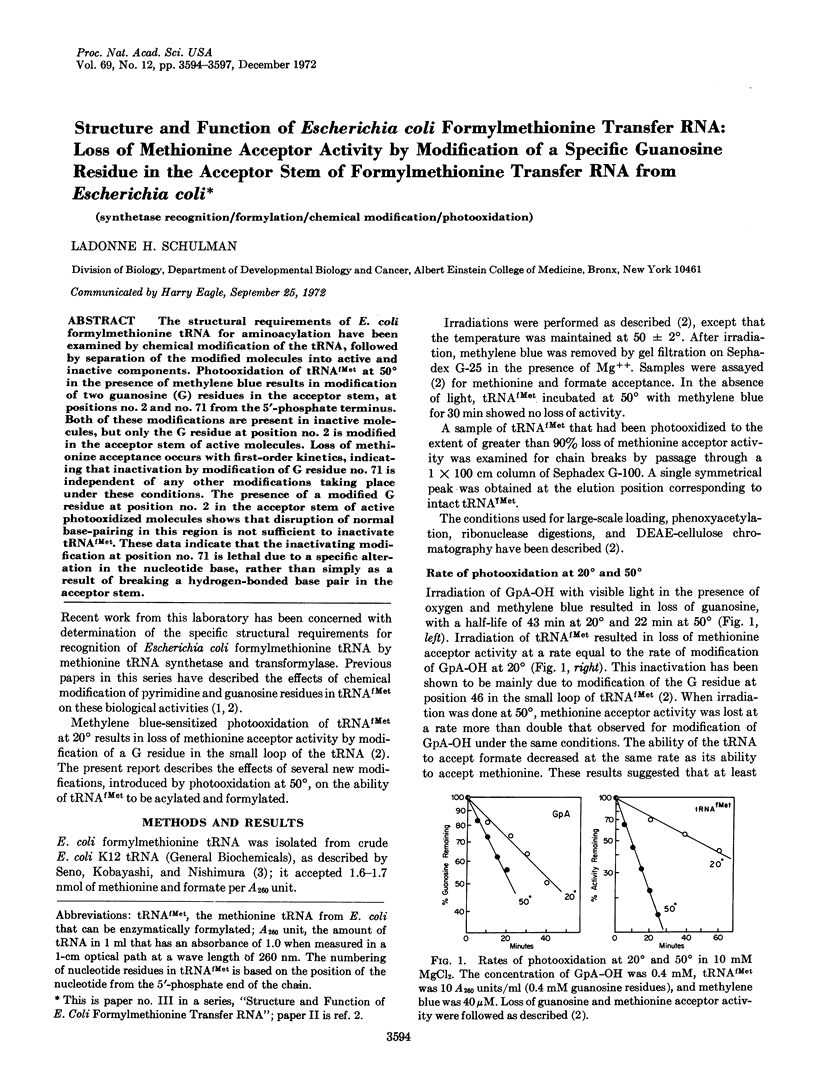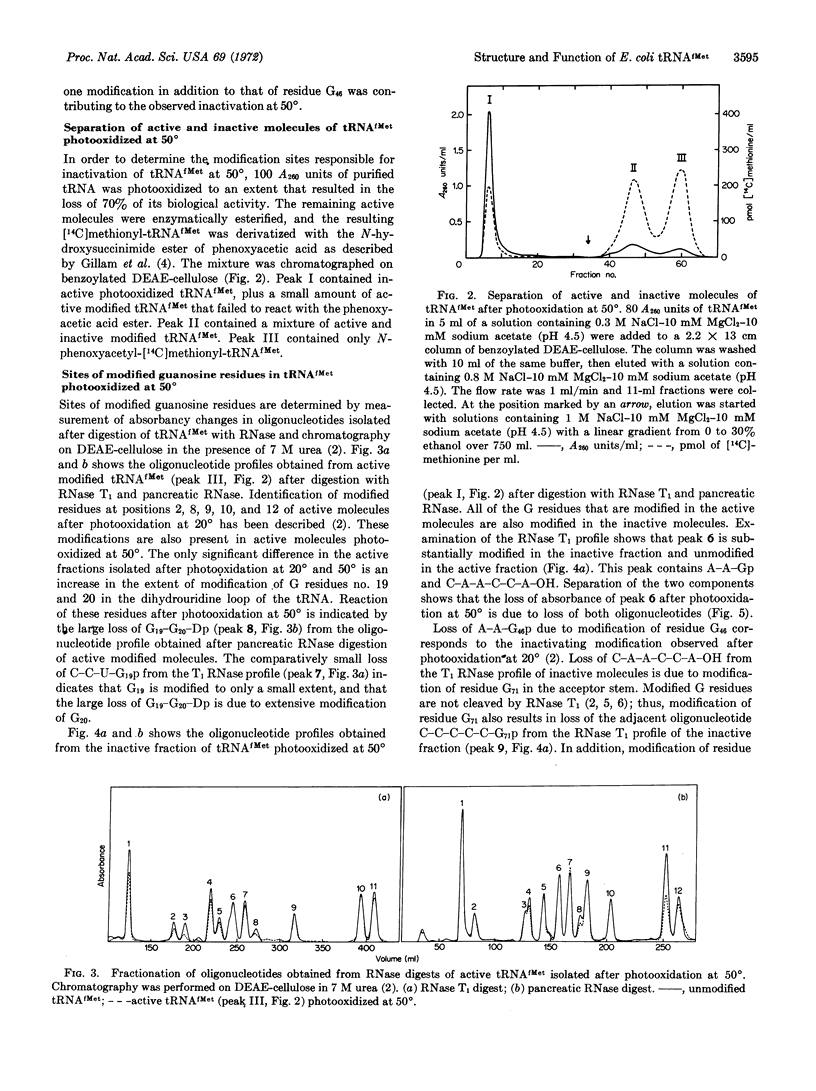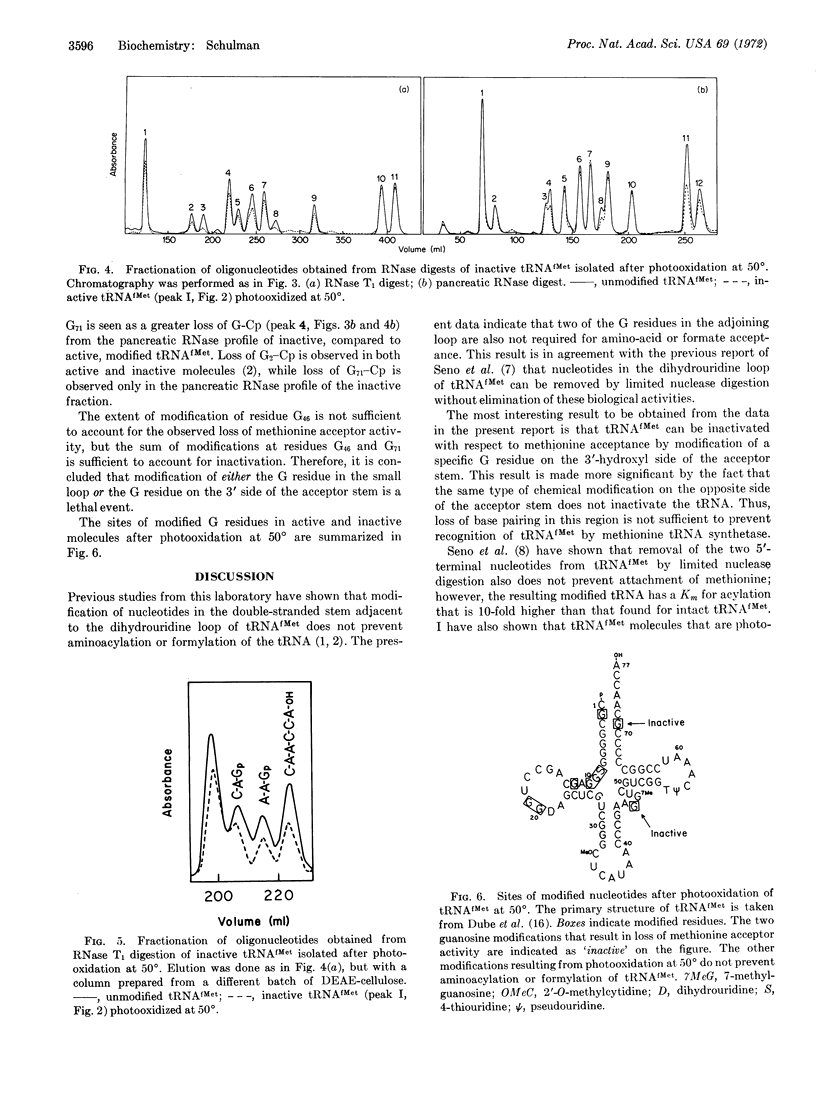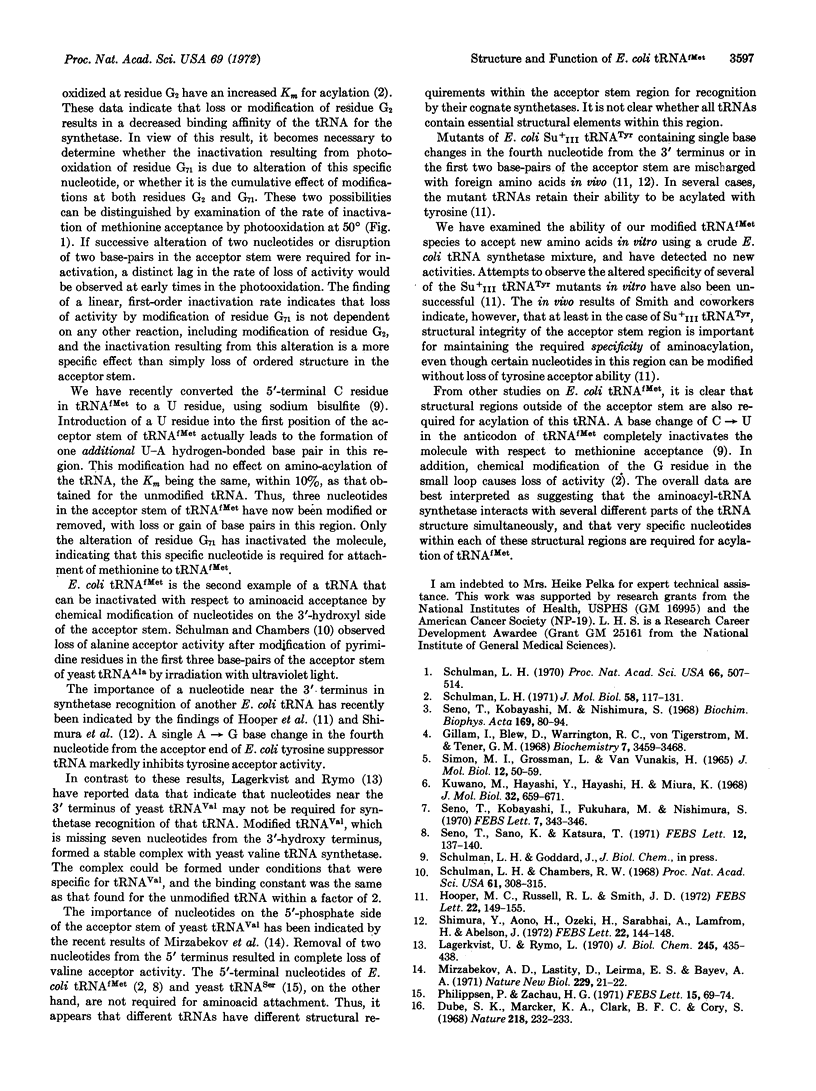Abstract
The structural requirements of E. coli formylmethionine tRNA for aminoacylation have been examined by chemical modification of the tRNA, followed by separation of the modified molecules into active and inactive components. Photooxidation of tRNAfMet at 50° in the presence of methylene blue results in modification of two guanosine (G) residues in the acceptor stem, at positions no. 2 and no. 71 from the 5′-phosphate terminus. Both of these modifications are present in inactive molecules, but only the G residue at position no. 2 is modified in the acceptor stem of active molecules. Loss of methionine acceptance occurs with first-order kinetics, indicating that inactivation by modification of G residue no. 71 is independent of any other modifications taking place under these conditions. The presence of a modified G residue at position no. 2 in the acceptor stem of active photooxidized molecules shows that disruption of normal base-pairing in this region is not sufficient to inactivate tRNAfMet. These data indicate that the inactivating modification at position no. 71 is lethal due to a specific alteration in the nucleotide base, rather than simply as a result of breaking a hydrogen-bonded base pair in the acceptor stem.
Keywords: synthetase recognition, formylation, chemical modification, photooxidation
Full text
PDF



Selected References
These references are in PubMed. This may not be the complete list of references from this article.
- Dube S. K., Marcker K. A., Clark B. F., Cory S. Nucleotide sequence of N-formyl-methionyl-transfer RNA. Nature. 1968 Apr 20;218(5138):232–233. doi: 10.1038/218232a0. [DOI] [PubMed] [Google Scholar]
- Gillam I., Blew D., Warrington R. C., von Tigerstrom M., Tener G. M. A general procedure for the isolation of specific transfer ribonucleic acids. Biochemistry. 1968 Oct;7(10):3459–3468. doi: 10.1021/bi00850a022. [DOI] [PubMed] [Google Scholar]
- Hooper M. L., Russell R. L., Smith J. D. Mischarging in mutant tyrosine transfer RNAs. FEBS Lett. 1972 Apr 15;22(1):149–155. doi: 10.1016/0014-5793(72)80241-2. [DOI] [PubMed] [Google Scholar]
- Kuwano M., Hayashi Y., Hayashi H., Miura K. Photochemical modification of transfer RNA and its effect on aminoacyl RNA synthesis. J Mol Biol. 1968 Mar 28;32(3):659–671. doi: 10.1016/0022-2836(68)90349-5. [DOI] [PubMed] [Google Scholar]
- Lagerkvist U., Rymo L. Structure and function of transfer ribonucleic acid. IV. Complexes between valyl transfer ribonucleic acid synthetase and structurally modified transfer ribonucleic acid specific for valine. J Biol Chem. 1970 Jan 25;245(2):435–438. [PubMed] [Google Scholar]
- Mirzabekov A. D., Lastity D., Levina E. S., Bayev A. A. Localization of two recognition sites in yeast valine tRNA I. Nat New Biol. 1971 Jan 6;229(1):21–22. doi: 10.1038/newbio229021a0. [DOI] [PubMed] [Google Scholar]
- Philippsen P., Zachau H. G. Fragments of yeast tRNA(Phe) and tRNA(Ser) prepared by partial digestion with spleen phosphodiesterase. FEBS Lett. 1971 Jun 2;15(1):69–74. doi: 10.1016/0014-5793(71)80081-9. [DOI] [PubMed] [Google Scholar]
- SIMON M. I., GROSSMAN L., VANVUNAKIS H. PHOTOSENSITIZED REACTION OF POLYRIBONUCLEOTIDES. I. EFFECTS ON THEIR SUSCEPTIBILITY TO ENZYME DIGESTION AND THEIR ABILITY TO ACT AS SYNTHETIC MESSENGERS. J Mol Biol. 1965 May;12:50–59. doi: 10.1016/s0022-2836(65)80281-9. [DOI] [PubMed] [Google Scholar]
- Schulman L. H., Chambers R. W. Transfer RNA, II. A structural basis for alanine acceptor activity. Proc Natl Acad Sci U S A. 1968 Sep;61(1):308–315. doi: 10.1073/pnas.61.1.308. [DOI] [PMC free article] [PubMed] [Google Scholar]
- Schulman L. H. Structure and function of E. coli formylmethionyl tRNA. I. Effect of modification of pyrimidine residues on aminoacyl synthetase recognition. Proc Natl Acad Sci U S A. 1970 Jun;66(2):507–514. doi: 10.1073/pnas.66.2.507. [DOI] [PMC free article] [PubMed] [Google Scholar]
- Schulman L. H. Structure and function of Escherichia coli formylmethionine transfer RNA. II. Effect of modification of guanosine residues on aminoacyl synthetase recognition. J Mol Biol. 1971 May 28;58(1):117–131. doi: 10.1016/0022-2836(71)90236-1. [DOI] [PubMed] [Google Scholar]
- Seno T., Kobayashi I., Fukuhara M., Nishimura S. Active complexes derived from Escherichia coli formylmethionine tRNA which lacks the dihydrouridine-containing loop. FEBS Lett. 1970 May 1;7(4):343–346. doi: 10.1016/0014-5793(70)80201-0. [DOI] [PubMed] [Google Scholar]
- Seno T., Kobayashi M., Nishimura S. Purification of Excherichia coli methionine tRNAF and methionine tRNAM and studies on their biophysical and biochemical properties. Biochim Biophys Acta. 1968 Nov 20;169(1):80–94. doi: 10.1016/0005-2787(68)90010-5. [DOI] [PubMed] [Google Scholar]
- Seno T., Sano K., Katsura T. Reconstitution of methionine-acceptor activity from fragments of E. coli tRNA(fMet) with pCpGp deleted from the 5'-terminus. FEBS Lett. 1971 Jan 12;12(3):137–140. doi: 10.1016/0014-5793(71)80052-2. [DOI] [PubMed] [Google Scholar]
- Shimura Y., Aono H., Ozeki H., Sarabhai A., Lamfrom H., Abelson J. Mutant tyrosine tRNA of altered amino acid specificity. FEBS Lett. 1972 Apr 15;22(1):144–148. doi: 10.1016/0014-5793(72)80240-0. [DOI] [PubMed] [Google Scholar]


